Pre-dreadnought Battleship on:
[Wikipedia]
[Google]
[Amazon]
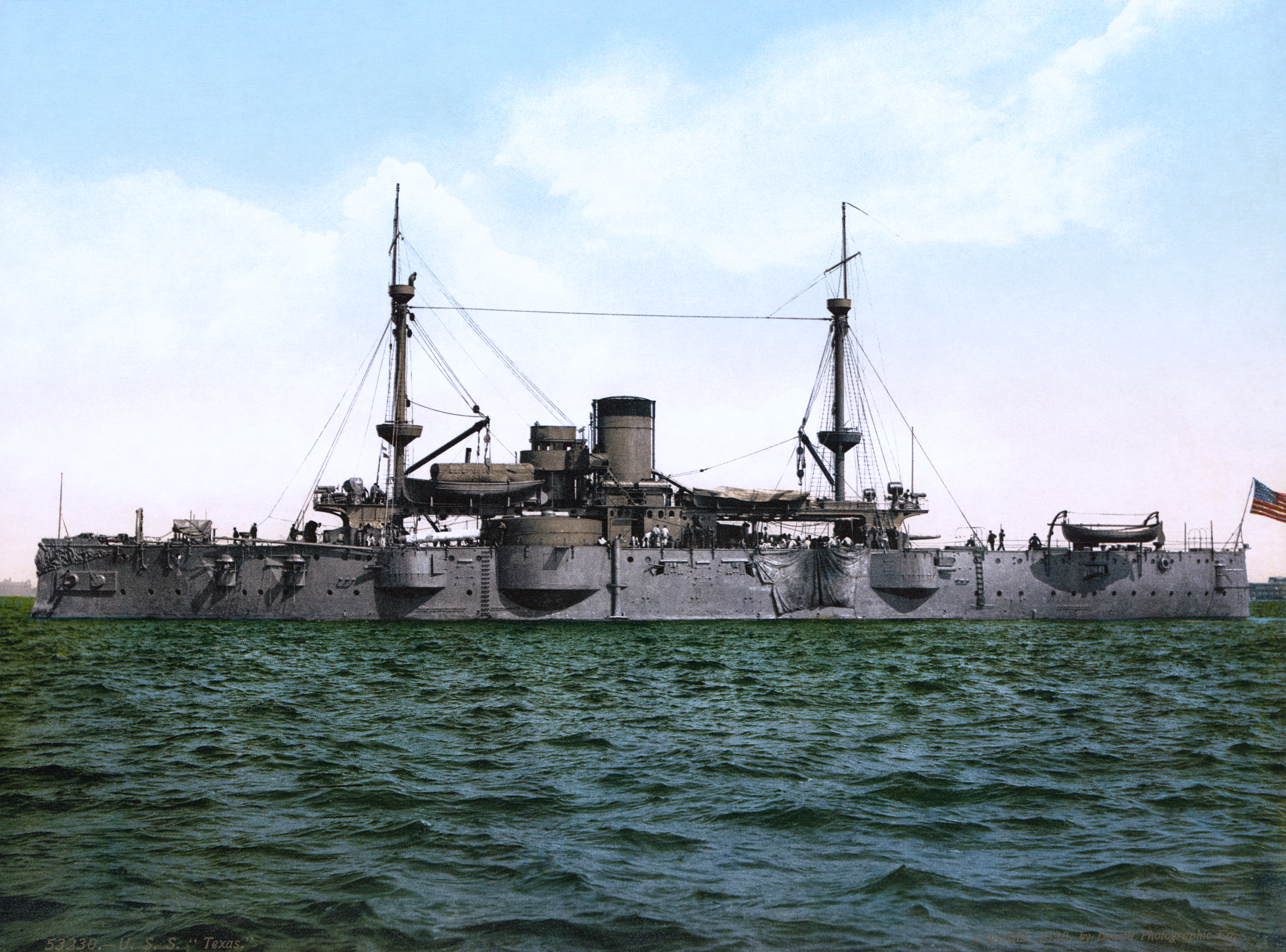 Pre-dreadnought battleships were sea-going battleships built between the mid- to late- 1880s and 1905, before the launch of in 1906. The pre-dreadnought ships replaced the ironclad battleships of the 1870s and 1880s. Built from steel, protected by case-hardened steel armour, and powered by
Pre-dreadnought battleships were sea-going battleships built between the mid- to late- 1880s and 1905, before the launch of in 1906. The pre-dreadnought ships replaced the ironclad battleships of the 1870s and 1880s. Built from steel, protected by case-hardened steel armour, and powered by  These battleships were abruptly made obsolete by the arrival of in 1906. ''Dreadnought'' followed the trend in battleship design to heavier, longer-ranged guns by adopting an "all-big-gun" armament scheme of ten 12-inch guns. Her innovative
These battleships were abruptly made obsolete by the arrival of in 1906. ''Dreadnought'' followed the trend in battleship design to heavier, longer-ranged guns by adopting an "all-big-gun" armament scheme of ten 12-inch guns. Her innovative
 The pre-dreadnought developed from the ironclad battleship. The first ironclads—the French ''Gloire'' and —looked much like sailing frigates, with three tall masts and broadside batteries, when they were commissioned in the early 1860s. HMVS ''Cerberus'', the first breastwork monitor, was launched in 1868, followed in 1871 by , a turreted ironclad which more resembled a pre-dreadnought than the previous, and its contemporary, turretless ironclads. Both ships dispensed with masts and carried four heavy guns in two turrets fore and aft. ''Devastation'' was the first ocean-worthy breastwork monitor, built to attack enemy coasts and harbours; because of her very low freeboard, she could not fight on the high seas as her decks would be swept by water and spray, interfering with the working of her guns. Navies worldwide continued to build masted, turretless battleships which had sufficient freeboard and were seaworthy enough to fight on the high seas.
The distinction between coast-assault battleship and cruising battleship became blurred with the Admiral-class ironclads, ordered in 1880. These ships reflected developments in ironclad design, being protected by iron-and-steel compound armour rather than
The pre-dreadnought developed from the ironclad battleship. The first ironclads—the French ''Gloire'' and —looked much like sailing frigates, with three tall masts and broadside batteries, when they were commissioned in the early 1860s. HMVS ''Cerberus'', the first breastwork monitor, was launched in 1868, followed in 1871 by , a turreted ironclad which more resembled a pre-dreadnought than the previous, and its contemporary, turretless ironclads. Both ships dispensed with masts and carried four heavy guns in two turrets fore and aft. ''Devastation'' was the first ocean-worthy breastwork monitor, built to attack enemy coasts and harbours; because of her very low freeboard, she could not fight on the high seas as her decks would be swept by water and spray, interfering with the working of her guns. Navies worldwide continued to build masted, turretless battleships which had sufficient freeboard and were seaworthy enough to fight on the high seas.
The distinction between coast-assault battleship and cruising battleship became blurred with the Admiral-class ironclads, ordered in 1880. These ships reflected developments in ironclad design, being protected by iron-and-steel compound armour rather than 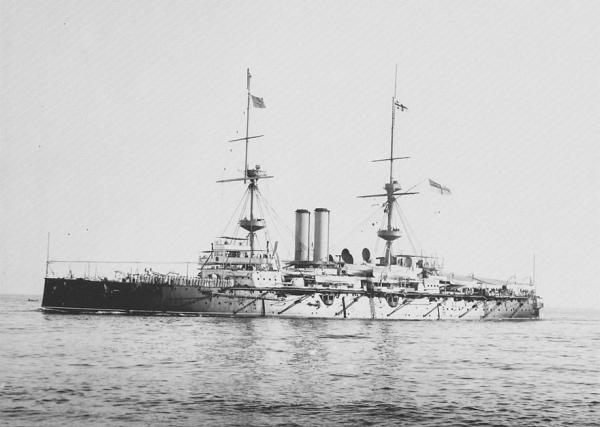 The subsequent of 1889 retained barbettes but were uniformly armed with guns; they were also significantly larger (at 14,000 tons displacement) and faster (because of triple-expansion steam engines) than the Admirals. Just as importantly, the ''Royal Sovereign''s had a higher freeboard, making them unequivocally capable of the high-seas battleship role.
The pre-dreadnought design reached maturity in 1895 with the . These ships were built and armoured entirely of steel, and their guns were now mounted in fully-enclosed rotating turrets. They also adopted main guns, which, because of advances in gun construction and the use of cordite propellant, were lighter and more powerful than the previous guns of larger calibre. The ''Majestic''s provided the model for battleship building in the Royal Navy and many other navies for years to come.
The subsequent of 1889 retained barbettes but were uniformly armed with guns; they were also significantly larger (at 14,000 tons displacement) and faster (because of triple-expansion steam engines) than the Admirals. Just as importantly, the ''Royal Sovereign''s had a higher freeboard, making them unequivocally capable of the high-seas battleship role.
The pre-dreadnought design reached maturity in 1895 with the . These ships were built and armoured entirely of steel, and their guns were now mounted in fully-enclosed rotating turrets. They also adopted main guns, which, because of advances in gun construction and the use of cordite propellant, were lighter and more powerful than the previous guns of larger calibre. The ''Majestic''s provided the model for battleship building in the Royal Navy and many other navies for years to come.
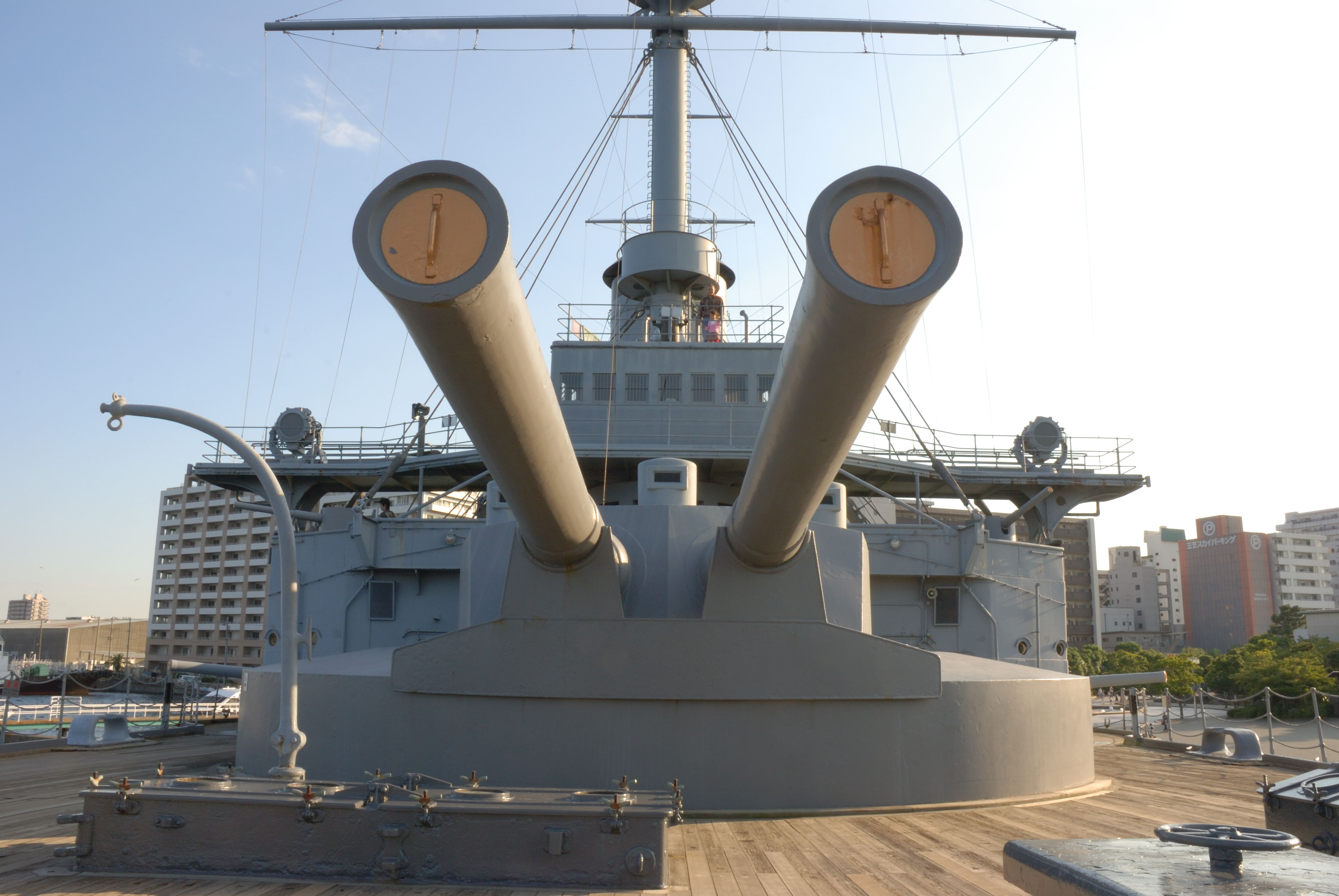 Pre-dreadnoughts carried guns of several different calibres, for different roles in ship-to-ship combat. The main armament was a main battery of four heavy guns, mounted in two centre-line turrets fore and aft. Very few pre-dreadnoughts deviated from this arrangement. These guns were slow-firing, and initially of limited accuracy; but they were the only guns heavy enough to penetrate the thick armour which protected the engines, magazines, and main guns of enemy battleships.Sumrall, p. 14.
The most common calibre for the main armament was , although some ships used smaller guns because they could attain higher rates of fire; British battleships from the ''Majestic'' class onwards carried this calibre, as did French ships from the ''
Pre-dreadnoughts carried guns of several different calibres, for different roles in ship-to-ship combat. The main armament was a main battery of four heavy guns, mounted in two centre-line turrets fore and aft. Very few pre-dreadnoughts deviated from this arrangement. These guns were slow-firing, and initially of limited accuracy; but they were the only guns heavy enough to penetrate the thick armour which protected the engines, magazines, and main guns of enemy battleships.Sumrall, p. 14.
The most common calibre for the main armament was , although some ships used smaller guns because they could attain higher rates of fire; British battleships from the ''Majestic'' class onwards carried this calibre, as did French ships from the '' While the calibre of the main battery remained quite constant, the performance of the guns improved as longer barrels were introduced. The introduction of slow-burning nitrocellulose and cordite propellant allowed the employment of a longer barrel, and therefore higher muzzle velocity—giving greater range and penetrating power for the same calibre of shell. Between the ''Majestic'' class and ''Dreadnought'', the length of the British 12-inch gun increased from 35 calibres to 45 and muzzle velocity increased from per second to per second.
While the calibre of the main battery remained quite constant, the performance of the guns improved as longer barrels were introduced. The introduction of slow-burning nitrocellulose and cordite propellant allowed the employment of a longer barrel, and therefore higher muzzle velocity—giving greater range and penetrating power for the same calibre of shell. Between the ''Majestic'' class and ''Dreadnought'', the length of the British 12-inch gun increased from 35 calibres to 45 and muzzle velocity increased from per second to per second.
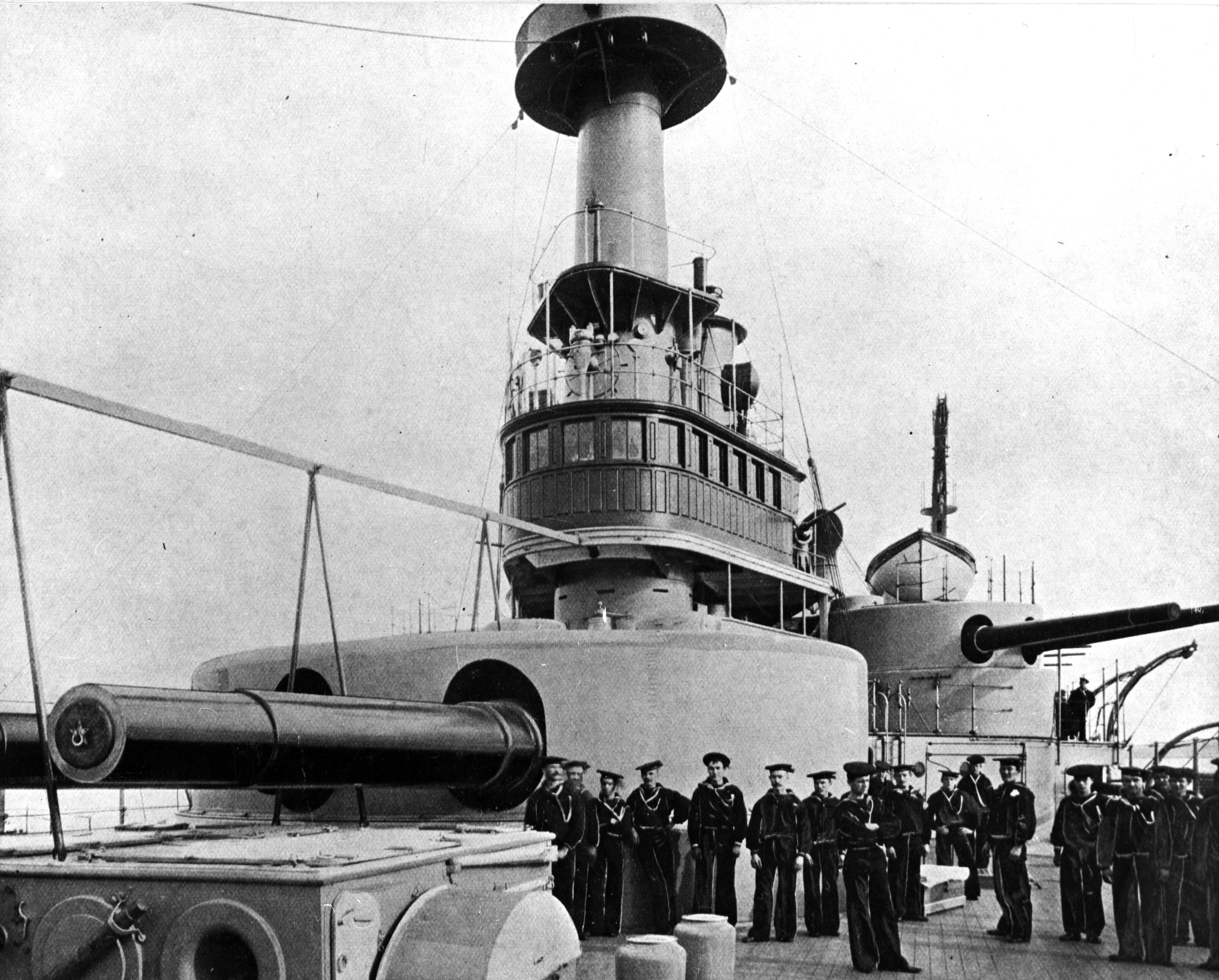
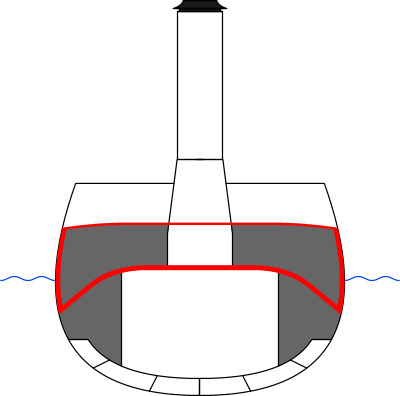 Pre-dreadnought battleships carried a considerable weight of steel armour. Experience showed that rather than giving the ship uniform armour protection, it was best to concentrate armour over critical areas. The central section of the hull, which housed the boilers and engines, was protected by the main belt, which ran from just below the waterline to some distance above it. This "central citadel" was intended to protect the engines from even the most powerful shells. The main armament and the magazines were protected by projections of thick armour from the main belt. The beginning of the pre-dreadnought era was marked by a move from mounting the main armament in open barbettes to an all-enclosed, turret mounting.Roberts, p. 117.
The main belt armour would normally taper to a lesser thickness along the side of the hull towards bow and stern; it might also taper up from the central citadel towards the superstructure. The deck was typically lightly armoured with 2 to 4 inches of steel. This lighter armour was to prevent high-explosive shells from wrecking the superstructure of the ship.
Pre-dreadnought battleships carried a considerable weight of steel armour. Experience showed that rather than giving the ship uniform armour protection, it was best to concentrate armour over critical areas. The central section of the hull, which housed the boilers and engines, was protected by the main belt, which ran from just below the waterline to some distance above it. This "central citadel" was intended to protect the engines from even the most powerful shells. The main armament and the magazines were protected by projections of thick armour from the main belt. The beginning of the pre-dreadnought era was marked by a move from mounting the main armament in open barbettes to an all-enclosed, turret mounting.Roberts, p. 117.
The main belt armour would normally taper to a lesser thickness along the side of the hull towards bow and stern; it might also taper up from the central citadel towards the superstructure. The deck was typically lightly armoured with 2 to 4 inches of steel. This lighter armour was to prevent high-explosive shells from wrecking the superstructure of the ship.
 The battleships of the late 1880s, for instance the , were armoured with iron and steel compound armour. This was soon replaced with more effective case-hardened steel armour made using the Harvey process developed in the United States. First tested in 1891, Harvey armour was commonplace in ships laid down from 1893 to 1895. However, its reign was brief; in 1895, the German ''Kaiser Friedrich III'' pioneered the superior Krupp armour. Europe adopted Krupp plate within five years, and only the United States persisted in using Harvey steel into the 20th century. The improving quality of armour plate meant that new ships could have better protection from a thinner and lighter armour belt; 12 inches (305 mm) of compound armour provided the same protection as just 7.5 inches (190 mm) of Harvey or 5.75 inches (133 mm) of Krupp.
The battleships of the late 1880s, for instance the , were armoured with iron and steel compound armour. This was soon replaced with more effective case-hardened steel armour made using the Harvey process developed in the United States. First tested in 1891, Harvey armour was commonplace in ships laid down from 1893 to 1895. However, its reign was brief; in 1895, the German ''Kaiser Friedrich III'' pioneered the superior Krupp armour. Europe adopted Krupp plate within five years, and only the United States persisted in using Harvey steel into the 20th century. The improving quality of armour plate meant that new ships could have better protection from a thinner and lighter armour belt; 12 inches (305 mm) of compound armour provided the same protection as just 7.5 inches (190 mm) of Harvey or 5.75 inches (133 mm) of Krupp.
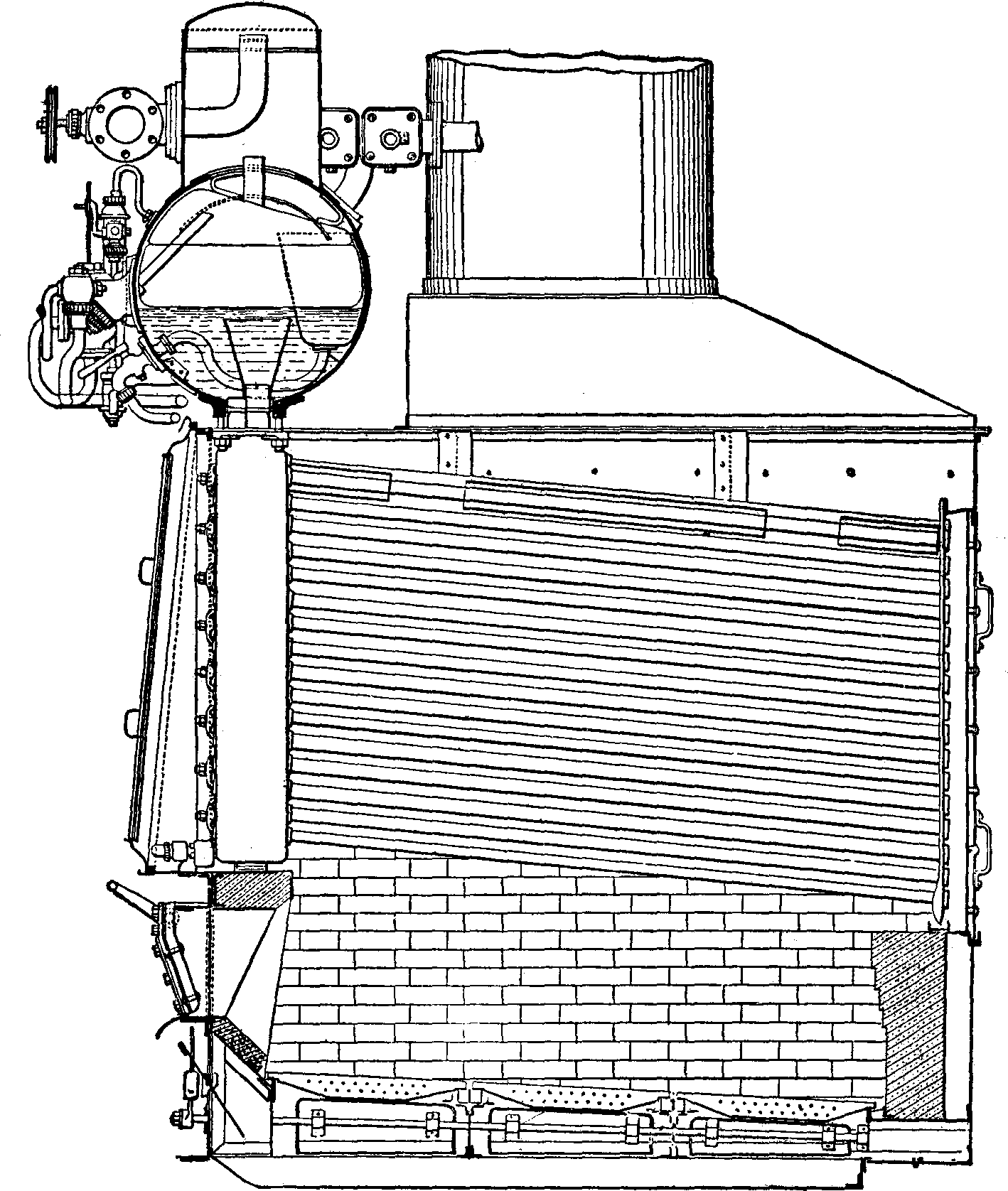 Almost all pre-dreadnoughts were powered by reciprocating
Almost all pre-dreadnoughts were powered by reciprocating 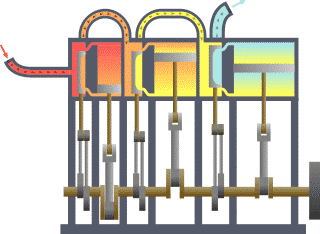 The engines drove either two or three screw propellers. France and Germany preferred the three-screw approach, which allowed the engines to be shorter and hence more easily protected; they were also more maneuverable and had better resistance to accidental damage. Triple screws were, however, generally larger and heavier than the twin-screw arrangements preferred by most other navies. The French also built the only class of
The engines drove either two or three screw propellers. France and Germany preferred the three-screw approach, which allowed the engines to be shorter and hence more easily protected; they were also more maneuverable and had better resistance to accidental damage. Triple screws were, however, generally larger and heavier than the twin-screw arrangements preferred by most other navies. The French also built the only class of
 The pre-dreadnought battleship in its heyday was the core of a very diverse navy. Many older ironclads were still in service. Battleships served alongside cruisers of many descriptions: modern armoured cruisers which were essentially cut-down battleships, lighter
The pre-dreadnought battleship in its heyday was the core of a very diverse navy. Many older ironclads were still in service. Battleships served alongside cruisers of many descriptions: modern armoured cruisers which were essentially cut-down battleships, lighter
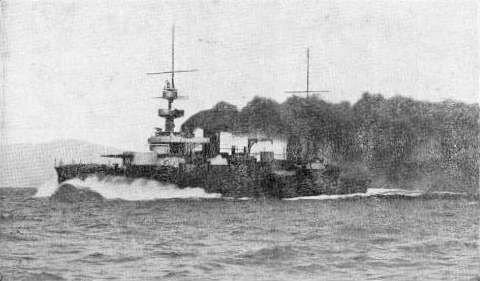 European navies remained dominant in the pre-dreadnought era. The
European navies remained dominant in the pre-dreadnought era. The 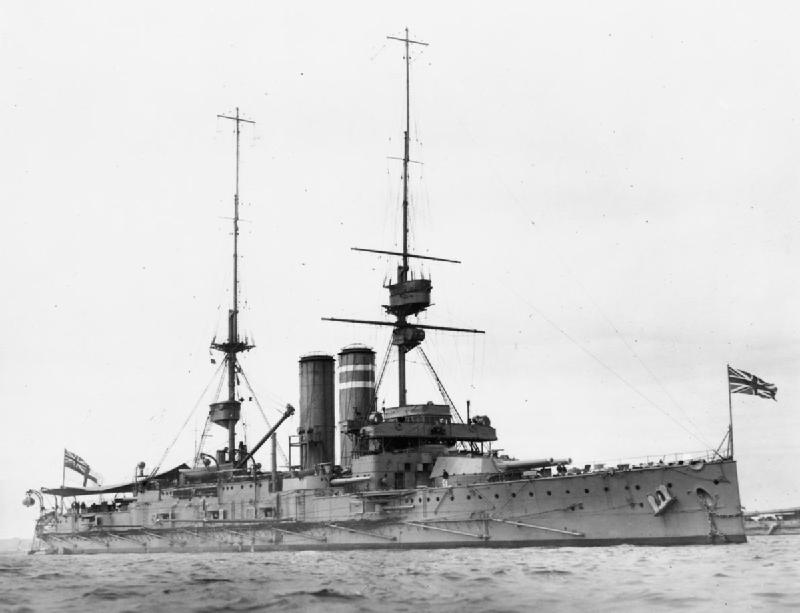 In 1889, Britain formally adopted a 'two power standard' committing it to building enough battleships to exceed the two largest other navies combined; at the time, this meant France and Russia, who became formally allied in the early 1890s. The and were followed by a regular programme of construction at a much quicker pace than in previous years. The , , and classes appeared in rapid succession from 1897 to 1905. Counting two ships ordered by Chile but taken over by the British, the Royal Navy had 39 pre-dreadnought battleships ready or being built by 1904, starting the count from the ''Majestic''s. Over two dozen older battleships remained in service. The last British pre-dreadnoughts, the , appeared after ''Dreadnought'' herself.
France, Britain's traditional naval rival, had paused its battleship building during the 1880s because of the influence of the Jeune École doctrine, which favoured torpedo boats to battleships. After the Jeune École's influence faded, the first French battleship laid down was ''Brennus'', in 1889. ''Brennus'' and the ships which followed her were individual, as opposed to the large classes of British ships; they also carried an idiosyncratic arrangement of heavy guns, with ''Brennus'' carrying three guns and the ships which followed carrying two 12-inch and two 10.8-inch in single turrets. The , laid down 1894–1896, were the first to adopt the standard four gun heavy armament. The Jeune École retained a strong influence on French naval strategy, and by the end of the 19th century France had abandoned competition with Britain in battleship numbers. The French suffered the most from the dreadnought revolution, with four ships of the still building when ''Dreadnought'' launched, and a further six of the begun afterwards.
In 1889, Britain formally adopted a 'two power standard' committing it to building enough battleships to exceed the two largest other navies combined; at the time, this meant France and Russia, who became formally allied in the early 1890s. The and were followed by a regular programme of construction at a much quicker pace than in previous years. The , , and classes appeared in rapid succession from 1897 to 1905. Counting two ships ordered by Chile but taken over by the British, the Royal Navy had 39 pre-dreadnought battleships ready or being built by 1904, starting the count from the ''Majestic''s. Over two dozen older battleships remained in service. The last British pre-dreadnoughts, the , appeared after ''Dreadnought'' herself.
France, Britain's traditional naval rival, had paused its battleship building during the 1880s because of the influence of the Jeune École doctrine, which favoured torpedo boats to battleships. After the Jeune École's influence faded, the first French battleship laid down was ''Brennus'', in 1889. ''Brennus'' and the ships which followed her were individual, as opposed to the large classes of British ships; they also carried an idiosyncratic arrangement of heavy guns, with ''Brennus'' carrying three guns and the ships which followed carrying two 12-inch and two 10.8-inch in single turrets. The , laid down 1894–1896, were the first to adopt the standard four gun heavy armament. The Jeune École retained a strong influence on French naval strategy, and by the end of the 19th century France had abandoned competition with Britain in battleship numbers. The French suffered the most from the dreadnought revolution, with four ships of the still building when ''Dreadnought'' launched, and a further six of the begun afterwards.
 Germany's first pre-dreadnoughts, the , were laid down in 1890. By 1905, a further 19 battleships were built or under construction, thanks to the sharp increase in naval expenditure justified by the 1898 and 1900 Navy Laws. This increase was due to the determination of the navy chief
Germany's first pre-dreadnoughts, the , were laid down in 1890. By 1905, a further 19 battleships were built or under construction, thanks to the sharp increase in naval expenditure justified by the 1898 and 1900 Navy Laws. This increase was due to the determination of the navy chief
 Pre-dreadnought battleships were sea-going battleships built between the mid- to late- 1880s and 1905, before the launch of in 1906. The pre-dreadnought ships replaced the ironclad battleships of the 1870s and 1880s. Built from steel, protected by case-hardened steel armour, and powered by
Pre-dreadnought battleships were sea-going battleships built between the mid- to late- 1880s and 1905, before the launch of in 1906. The pre-dreadnought ships replaced the ironclad battleships of the 1870s and 1880s. Built from steel, protected by case-hardened steel armour, and powered by coal
Coal is a combustible black or brownish-black sedimentary rock, formed as stratum, rock strata called coal seams. Coal is mostly carbon with variable amounts of other Chemical element, elements, chiefly hydrogen, sulfur, oxygen, and nitrogen ...
-fired triple-expansion steam engines, pre-dreadnought battleships carried a main battery of very heavy guns in fully enclosed rotating turrets
Turret may refer to:
* Turret (architecture), a small tower that projects above the wall of a building
* Gun turret, a mechanism of a projectile-firing weapon
* Objective turret, an indexable holder of multiple lenses in an optical microscope
* M ...
supported by one or more secondary batteries
A rechargeable battery, storage battery, or secondary cell (formally a type of energy accumulator), is a type of electrical battery which can be charged, discharged into a load, and recharged many times, as opposed to a disposable or prim ...
of lighter weapons.
In contrast to the multifarious development of ironclad warships in preceding decades, the 1890s saw navies worldwide start to build battleships to a common design as dozens of ships essentially followed the design of the Royal Navy
The Royal Navy (RN) is the United Kingdom's naval warfare force. Although warships were used by Kingdom of England, English and Kingdom of Scotland, Scottish kings from the early medieval period, the first major maritime engagements were foug ...
's . The similarity in appearance of battleships in the 1890s was underlined by the increasing number of ships being built. New naval powers such as Germany
Germany, officially the Federal Republic of Germany (FRG),, is a country in Central Europe. It is the most populous member state of the European Union. Germany lies between the Baltic and North Sea to the north and the Alps to the sou ...
, Japan, the United States
The United States of America (U.S.A. or USA), commonly known as the United States (U.S. or US) or America, is a country primarily located in North America. It consists of 50 U.S. state, states, a Washington, D.C., federal district, five ma ...
, and to a lesser extent Italy
Italy ( it, Italia ), officially the Italian Republic, ) or the Republic of Italy, is a country in Southern Europe. It is located in the middle of the Mediterranean Sea, and its territory largely coincides with the homonymous geographical ...
and Austria-Hungary
Austria-Hungary, often referred to as the Austro-Hungarian Empire,, the Dual Monarchy, or Austria, was a constitutional monarchy and great power in Central Europe between 1867 and 1918. It was formed with the Austro-Hungarian Compromise of ...
, began to establish themselves with fleets of pre-dreadnoughts. Meanwhile, the battleship fleets of the United Kingdom, France
France (), officially the French Republic ( ), is a country primarily located in Western Europe. It also comprises of overseas regions and territories in the Americas and the Atlantic, Pacific and Indian Oceans. Its metropolitan ar ...
, and Russia
Russia (, , ), or the Russian Federation, is a transcontinental country spanning Eastern Europe and Northern Asia. It is the largest country in the world, with its internationally recognised territory covering , and encompassing one-eigh ...
expanded to meet these new threats. The last decisive clash of pre-dreadnought fleets was between the Imperial Japanese Navy
The Imperial Japanese Navy (IJN; Kyūjitai: Shinjitai: ' 'Navy of the Greater Japanese Empire', or ''Nippon Kaigun'', 'Japanese Navy') was the navy of the Empire of Japan from 1868 to 1945, when it was dissolved following Japan's surrender ...
and the Imperial Russian Navy
The Imperial Russian Navy () operated as the navy of the Russian Tsardom and later the Russian Empire from 1696 to 1917. Formally established in 1696, it lasted until dissolved in the wake of the February Revolution of 1917. It developed from ...
at the Battle of Tsushima
The Battle of Tsushima (Japanese:対馬沖海戦, Tsushimaoki''-Kaisen'', russian: Цусимское сражение, ''Tsusimskoye srazheniye''), also known as the Battle of Tsushima Strait and the Naval Battle of Sea of Japan (Japanese: 日 ...
on 27 May 1905.
 These battleships were abruptly made obsolete by the arrival of in 1906. ''Dreadnought'' followed the trend in battleship design to heavier, longer-ranged guns by adopting an "all-big-gun" armament scheme of ten 12-inch guns. Her innovative
These battleships were abruptly made obsolete by the arrival of in 1906. ''Dreadnought'' followed the trend in battleship design to heavier, longer-ranged guns by adopting an "all-big-gun" armament scheme of ten 12-inch guns. Her innovative steam turbine
A steam turbine is a machine that extracts thermal energy from pressurized steam and uses it to do mechanical work on a rotating output shaft. Its modern manifestation was invented by Charles Parsons in 1884. Fabrication of a modern steam turb ...
engines also made her faster.Massie, ''Dreadnought'', pp. 474–475. The existing pre-dreadnoughts were decisively outclassed, and new and more powerful battleships were from then on known as dreadnought
The dreadnought (alternatively spelled dreadnaught) was the predominant type of battleship in the early 20th century. The first of the kind, the Royal Navy's , had such an impact when launched in 1906 that similar battleships built after her ...
s. At the same time, the ships that had been laid down
Laying the keel or laying down is the formal recognition of the start of a ship's construction. It is often marked with a ceremony attended by dignitaries from the shipbuilding company and the ultimate owners of the ship.
Keel laying is one ...
before were designated pre-dreadnoughts.
Evolution
 The pre-dreadnought developed from the ironclad battleship. The first ironclads—the French ''Gloire'' and —looked much like sailing frigates, with three tall masts and broadside batteries, when they were commissioned in the early 1860s. HMVS ''Cerberus'', the first breastwork monitor, was launched in 1868, followed in 1871 by , a turreted ironclad which more resembled a pre-dreadnought than the previous, and its contemporary, turretless ironclads. Both ships dispensed with masts and carried four heavy guns in two turrets fore and aft. ''Devastation'' was the first ocean-worthy breastwork monitor, built to attack enemy coasts and harbours; because of her very low freeboard, she could not fight on the high seas as her decks would be swept by water and spray, interfering with the working of her guns. Navies worldwide continued to build masted, turretless battleships which had sufficient freeboard and were seaworthy enough to fight on the high seas.
The distinction between coast-assault battleship and cruising battleship became blurred with the Admiral-class ironclads, ordered in 1880. These ships reflected developments in ironclad design, being protected by iron-and-steel compound armour rather than
The pre-dreadnought developed from the ironclad battleship. The first ironclads—the French ''Gloire'' and —looked much like sailing frigates, with three tall masts and broadside batteries, when they were commissioned in the early 1860s. HMVS ''Cerberus'', the first breastwork monitor, was launched in 1868, followed in 1871 by , a turreted ironclad which more resembled a pre-dreadnought than the previous, and its contemporary, turretless ironclads. Both ships dispensed with masts and carried four heavy guns in two turrets fore and aft. ''Devastation'' was the first ocean-worthy breastwork monitor, built to attack enemy coasts and harbours; because of her very low freeboard, she could not fight on the high seas as her decks would be swept by water and spray, interfering with the working of her guns. Navies worldwide continued to build masted, turretless battleships which had sufficient freeboard and were seaworthy enough to fight on the high seas.
The distinction between coast-assault battleship and cruising battleship became blurred with the Admiral-class ironclads, ordered in 1880. These ships reflected developments in ironclad design, being protected by iron-and-steel compound armour rather than wrought iron
Wrought iron is an iron alloy with a very low carbon content (less than 0.08%) in contrast to that of cast iron (2.1% to 4%). It is a semi-fused mass of iron with fibrous slag inclusions (up to 2% by weight), which give it a wood-like "grain" ...
. Equipped with breech-loading
A breechloader is a firearm in which the user loads the ammunition ( cartridge or shell) via the rear (breech) end of its barrel, as opposed to a muzzleloader, which loads ammunition via the front ( muzzle).
Modern firearms are generally b ...
guns of between 12-inch and 16 ¼-inch (305 mm and 413 mm) calibre, the Admirals continued the trend of ironclad warships mounting gigantic weapons. The guns were mounted in open barbette
Barbettes are several types of gun emplacement in terrestrial fortifications or on naval ships.
In recent naval usage, a barbette is a protective circular armour support for a heavy gun turret. This evolved from earlier forms of gun protectio ...
s to save weight. Some historians see these ships as a vital step towards pre-dreadnoughts; others view them as a confused and unsuccessful design.
 The subsequent of 1889 retained barbettes but were uniformly armed with guns; they were also significantly larger (at 14,000 tons displacement) and faster (because of triple-expansion steam engines) than the Admirals. Just as importantly, the ''Royal Sovereign''s had a higher freeboard, making them unequivocally capable of the high-seas battleship role.
The pre-dreadnought design reached maturity in 1895 with the . These ships were built and armoured entirely of steel, and their guns were now mounted in fully-enclosed rotating turrets. They also adopted main guns, which, because of advances in gun construction and the use of cordite propellant, were lighter and more powerful than the previous guns of larger calibre. The ''Majestic''s provided the model for battleship building in the Royal Navy and many other navies for years to come.
The subsequent of 1889 retained barbettes but were uniformly armed with guns; they were also significantly larger (at 14,000 tons displacement) and faster (because of triple-expansion steam engines) than the Admirals. Just as importantly, the ''Royal Sovereign''s had a higher freeboard, making them unequivocally capable of the high-seas battleship role.
The pre-dreadnought design reached maturity in 1895 with the . These ships were built and armoured entirely of steel, and their guns were now mounted in fully-enclosed rotating turrets. They also adopted main guns, which, because of advances in gun construction and the use of cordite propellant, were lighter and more powerful than the previous guns of larger calibre. The ''Majestic''s provided the model for battleship building in the Royal Navy and many other navies for years to come.
Armament
Main battery
 Pre-dreadnoughts carried guns of several different calibres, for different roles in ship-to-ship combat. The main armament was a main battery of four heavy guns, mounted in two centre-line turrets fore and aft. Very few pre-dreadnoughts deviated from this arrangement. These guns were slow-firing, and initially of limited accuracy; but they were the only guns heavy enough to penetrate the thick armour which protected the engines, magazines, and main guns of enemy battleships.Sumrall, p. 14.
The most common calibre for the main armament was , although some ships used smaller guns because they could attain higher rates of fire; British battleships from the ''Majestic'' class onwards carried this calibre, as did French ships from the ''
Pre-dreadnoughts carried guns of several different calibres, for different roles in ship-to-ship combat. The main armament was a main battery of four heavy guns, mounted in two centre-line turrets fore and aft. Very few pre-dreadnoughts deviated from this arrangement. These guns were slow-firing, and initially of limited accuracy; but they were the only guns heavy enough to penetrate the thick armour which protected the engines, magazines, and main guns of enemy battleships.Sumrall, p. 14.
The most common calibre for the main armament was , although some ships used smaller guns because they could attain higher rates of fire; British battleships from the ''Majestic'' class onwards carried this calibre, as did French ships from the ''Charlemagne
Charlemagne ( , ) or Charles the Great ( la, Carolus Magnus; german: Karl der Große; 2 April 747 – 28 January 814), a member of the Carolingian dynasty, was King of the Franks from 768, King of the Lombards from 774, and the first Em ...
'' class, laid down in 1894. Japan, importing most of its guns from Britain, used 12-inch guns. The United States used both and guns for most of the 1890s until the , laid down in 1899 (and not to be confused with the earlier of Spanish–American War
, partof = the Philippine Revolution, the decolonization of the Americas, and the Cuban War of Independence
, image = Collage infobox for Spanish-American War.jpg
, image_size = 300px
, caption = (cl ...
notoriety), after which the 12-inch gun was universal. The Russians used both 12 and as their main armament; the , , ''Tsesarevich'', and had main batteries while the mounted guns. The first German pre-dreadnought class used an gun but decreased to a gun for the two following classes and returned to 11-inch guns with the .
 While the calibre of the main battery remained quite constant, the performance of the guns improved as longer barrels were introduced. The introduction of slow-burning nitrocellulose and cordite propellant allowed the employment of a longer barrel, and therefore higher muzzle velocity—giving greater range and penetrating power for the same calibre of shell. Between the ''Majestic'' class and ''Dreadnought'', the length of the British 12-inch gun increased from 35 calibres to 45 and muzzle velocity increased from per second to per second.
While the calibre of the main battery remained quite constant, the performance of the guns improved as longer barrels were introduced. The introduction of slow-burning nitrocellulose and cordite propellant allowed the employment of a longer barrel, and therefore higher muzzle velocity—giving greater range and penetrating power for the same calibre of shell. Between the ''Majestic'' class and ''Dreadnought'', the length of the British 12-inch gun increased from 35 calibres to 45 and muzzle velocity increased from per second to per second.
Secondary battery
Pre-dreadnoughts also carried a secondary battery. This consisted of smaller guns, typically , though any calibre from 4 to 9.4 inches (100 to 240 mm) could be used. Virtually all secondary guns were " quick firing", employing a number of innovations to increase the rate of fire. The propellant was provided in a brass cartridge, and both the breech mechanism and the mounting were suitable for rapid aiming and reloading. The role of the secondary battery was to damage the less armoured parts of an enemy battleship; while unable to penetrate the main armour belt, it might score hits on lightly armoured areas like the bridge, or start fires. Equally important, the secondary armament was to be used against enemy cruisers, destroyers, and eventorpedo boat
A torpedo boat is a relatively small and fast naval ship designed to carry torpedoes into battle. The first designs were steam-powered craft dedicated to ramming enemy ships with explosive spar torpedoes. Later evolutions launched variants of s ...
s. A medium-calibre gun could expect to penetrate the light armour of smaller ships, while the rate of fire of the secondary battery was important in scoring a hit against a small, manoeuvrable target. Secondary guns were mounted in a variety of ways; sometimes carried in turrets, they were just as often positioned in fixed armoured casemates in the side of the hull, or in unarmoured positions on upper decks.

Intermediate battery
Some of the pre-dreadnoughts carried an "intermediate" battery, typically of 8-inch (203 mm) to 10-inch calibre. The intermediate battery was a method of packing more heavy firepower into the same battleship, principally of use against battleships or at long ranges. The United States Navy pioneered the intermediate battery concept in the , , and classes, but not in the battleships laid down between 1897 and 1901.Roberts, p. 122. Shortly after the USN re-adopted the intermediate battery, the British, Italian, Russian, French, and Japanese navies laid down intermediate-battery ships. This later generation of intermediate-battery ships almost without exception finished building after ''Dreadnought'', and hence were obsolete before completion.Tertiary battery
The pre-dreadnought's armament was completed by a tertiary battery of light, rapid-fire guns. These could be of any calibre from 3-inch (76 mm) down tomachine gun
A machine gun is a fully automatic, rifled autoloading firearm designed for sustained direct fire with rifle cartridges. Other automatic firearms such as automatic shotguns and automatic rifles (including assault rifles and battle rifl ...
s. Their role was to give short-range protection against torpedo boats, or to rake the deck and superstructure of a battleship.
Torpedoes
In addition to their gun armament, many pre-dreadnought battleships were armed withtorpedoes
A modern torpedo is an underwater ranged weapon launched above or below the water surface, self-propelled towards a target, and with an explosive warhead designed to detonate either on contact with or in proximity to the target. Historically, su ...
, fired from fixed tubes located either above or below the waterline. By the pre-dreadnought era the torpedo was typically in diameter and had an effective range of several thousand metres. However, it was virtually unknown for a battleship to score a hit with a torpedo.
Range of combat
During the ironclad age, the range of engagements increased; in the Sino-Japanese War of 1894–95 battles were fought at around 1 mile (1.5 km), while in theBattle of the Yellow Sea
The Battle of the Yellow Sea ( ja, 黄海海戦, Kōkai kaisen; russian: Бой в Жёлтом море) was a major naval battle of the Russo-Japanese War, fought on 10 August 1904. In the Russian Navy, it was referred to as the Battle of 10 ...
in 1904, the Russian and Japanese fleets fought at ranges of 3.5 miles (5.5 km). The increase in engagement range was due in part to the longer range of torpedoes, and in part to improved gunnery and fire control. In consequence, shipbuilders tended towards heavier secondary armament, of the same calibre that the "intermediate" battery had been; the Royal Navy's last pre-dreadnought class, the ''Lord Nelson'' class, carried ten 9.2-inch guns as secondary armament. Ships with a uniform, heavy secondary battery are often referred to as "semi-dreadnoughts".
Protection
 Pre-dreadnought battleships carried a considerable weight of steel armour. Experience showed that rather than giving the ship uniform armour protection, it was best to concentrate armour over critical areas. The central section of the hull, which housed the boilers and engines, was protected by the main belt, which ran from just below the waterline to some distance above it. This "central citadel" was intended to protect the engines from even the most powerful shells. The main armament and the magazines were protected by projections of thick armour from the main belt. The beginning of the pre-dreadnought era was marked by a move from mounting the main armament in open barbettes to an all-enclosed, turret mounting.Roberts, p. 117.
The main belt armour would normally taper to a lesser thickness along the side of the hull towards bow and stern; it might also taper up from the central citadel towards the superstructure. The deck was typically lightly armoured with 2 to 4 inches of steel. This lighter armour was to prevent high-explosive shells from wrecking the superstructure of the ship.
Pre-dreadnought battleships carried a considerable weight of steel armour. Experience showed that rather than giving the ship uniform armour protection, it was best to concentrate armour over critical areas. The central section of the hull, which housed the boilers and engines, was protected by the main belt, which ran from just below the waterline to some distance above it. This "central citadel" was intended to protect the engines from even the most powerful shells. The main armament and the magazines were protected by projections of thick armour from the main belt. The beginning of the pre-dreadnought era was marked by a move from mounting the main armament in open barbettes to an all-enclosed, turret mounting.Roberts, p. 117.
The main belt armour would normally taper to a lesser thickness along the side of the hull towards bow and stern; it might also taper up from the central citadel towards the superstructure. The deck was typically lightly armoured with 2 to 4 inches of steel. This lighter armour was to prevent high-explosive shells from wrecking the superstructure of the ship.
 The battleships of the late 1880s, for instance the , were armoured with iron and steel compound armour. This was soon replaced with more effective case-hardened steel armour made using the Harvey process developed in the United States. First tested in 1891, Harvey armour was commonplace in ships laid down from 1893 to 1895. However, its reign was brief; in 1895, the German ''Kaiser Friedrich III'' pioneered the superior Krupp armour. Europe adopted Krupp plate within five years, and only the United States persisted in using Harvey steel into the 20th century. The improving quality of armour plate meant that new ships could have better protection from a thinner and lighter armour belt; 12 inches (305 mm) of compound armour provided the same protection as just 7.5 inches (190 mm) of Harvey or 5.75 inches (133 mm) of Krupp.
The battleships of the late 1880s, for instance the , were armoured with iron and steel compound armour. This was soon replaced with more effective case-hardened steel armour made using the Harvey process developed in the United States. First tested in 1891, Harvey armour was commonplace in ships laid down from 1893 to 1895. However, its reign was brief; in 1895, the German ''Kaiser Friedrich III'' pioneered the superior Krupp armour. Europe adopted Krupp plate within five years, and only the United States persisted in using Harvey steel into the 20th century. The improving quality of armour plate meant that new ships could have better protection from a thinner and lighter armour belt; 12 inches (305 mm) of compound armour provided the same protection as just 7.5 inches (190 mm) of Harvey or 5.75 inches (133 mm) of Krupp.
Propulsion
 Almost all pre-dreadnoughts were powered by reciprocating
Almost all pre-dreadnoughts were powered by reciprocating steam engine
A steam engine is a heat engine that performs mechanical work using steam as its working fluid. The steam engine uses the force produced by steam pressure to push a piston back and forth inside a cylinder. This pushing force can be ...
s. Most were capable of top speeds between 16 and . The ironclads of the 1880s used compound engine
A compound engine is an engine that has more than one stage for recovering energy from the same working fluid, with the exhaust from the first stage passing through the second stage, and in some cases then on to another subsequent stage or even s ...
s, and by the end of the 1880s the even-more efficient triple expansion compound engine was in use. Some fleets, though not the British, adopted the quadruple-expansion steam engine.Roberts, p. 114.
The main improvement in engine performance during the pre-dreadnought period came from the adoption of increasingly higher pressure steam from the boiler. Scotch marine boilers were superseded by more compact water-tube boilers, allowing higher-pressure steam to be produced with less fuel consumption. Water-tube boilers were also safer, with less risk of explosion, and more flexible than fire-tube types. The Belleville-type water-tube boiler had been introduced in the French fleet as early as 1879, but it took until 1894 for the Royal Navy to adopt it for armoured cruisers and pre-dreadnoughts; other water-tube boilers followed in navies worldwide.
 The engines drove either two or three screw propellers. France and Germany preferred the three-screw approach, which allowed the engines to be shorter and hence more easily protected; they were also more maneuverable and had better resistance to accidental damage. Triple screws were, however, generally larger and heavier than the twin-screw arrangements preferred by most other navies. The French also built the only class of
The engines drove either two or three screw propellers. France and Germany preferred the three-screw approach, which allowed the engines to be shorter and hence more easily protected; they were also more maneuverable and had better resistance to accidental damage. Triple screws were, however, generally larger and heavier than the twin-screw arrangements preferred by most other navies. The French also built the only class of turbine
A turbine ( or ) (from the Greek , ''tyrbē'', or Latin ''turbo'', meaning vortex) is a rotary mechanical device that extracts energy from a fluid flow and converts it into useful work. The work produced by a turbine can be used for generating ...
powered pre-dreadnought battleships, the of 1907.
Coal was the almost exclusive fuel for the pre-dreadnought period, though navies made the first experiments with oil propulsion in the late 1890s. An extra knot or two of speed could be gained by applying a 'forced draught' to the furnaces, where air was pumped into the furnaces, but this risked damage to the boilers.
Pre-dreadnought fleets and battles
 The pre-dreadnought battleship in its heyday was the core of a very diverse navy. Many older ironclads were still in service. Battleships served alongside cruisers of many descriptions: modern armoured cruisers which were essentially cut-down battleships, lighter
The pre-dreadnought battleship in its heyday was the core of a very diverse navy. Many older ironclads were still in service. Battleships served alongside cruisers of many descriptions: modern armoured cruisers which were essentially cut-down battleships, lighter protected cruiser
Protected cruisers, a type of naval cruiser of the late-19th century, gained their description because an armoured deck offered protection for vital machine-spaces from fragments caused by shells exploding above them. Protected cruisers r ...
s, and even older unarmoured cruisers, sloops and frigates whether built out of steel, iron or wood. The battleships were threatened by torpedo boats; it was during the pre-dreadnought era that the first destroyers were constructed to deal with the torpedo-boat threat, though at the same time the first effective submarines were being constructed.
The pre-dreadnought age saw the beginning of the end of the 19th century naval balance of power in which France and Russia vied for competition against the massive Royal Navy
The Royal Navy (RN) is the United Kingdom's naval warfare force. Although warships were used by Kingdom of England, English and Kingdom of Scotland, Scottish kings from the early medieval period, the first major maritime engagements were foug ...
, and saw the start of the rise of the 'new naval powers' of Germany, Japan and the USA. The new ships of the Imperial Japanese Navy and to a lesser extent the U.S. Navy supported those powers' colonial expansion.
While pre-dreadnoughts were adopted worldwide, there were no clashes between pre-dreadnought battleships until the very end of their period of dominance. The First Sino-Japanese War
The First Sino-Japanese War (25 July 1894 – 17 April 1895) was a conflict between China and Japan primarily over influence in Korea. After more than six months of unbroken successes by Japanese land and naval forces and the loss of the p ...
in 1894–95 influenced pre-dreadnought development, but this had been a clash between Chinese battleships and a Japanese fleet consisting of mostly cruisers. The Spanish–American War of 1898 was also a mismatch, with the American pre-dreadnought fleet engaging Spanish shore batteries at San Juan and then a Spanish squadron of armoured cruisers and destroyers at the Battle of Santiago de Cuba
The Battle of Santiago de Cuba was a decisive naval engagement that occurred on July 3, 1898 between an American fleet, led by William T. Sampson and Winfield Scott Schley, against a Spanish fleet led by Pascual Cervera y Topete, which occur ...
. Not until the Russo-Japanese War
The Russo-Japanese War ( ja, 日露戦争, Nichiro sensō, Japanese-Russian War; russian: Ру́сско-япóнская войнá, Rússko-yapónskaya voyná) was fought between the Empire of Japan and the Russian Empire during 1904 and 1 ...
of 1904–05 did pre-dreadnoughts engage on an equal footing. This happened in three battles: the Russian tactical victory during the Battle of Port Arthur
The of 8–9 February 1904 marked the commencement of the Russo-Japanese War. It began with a surprise night attack by a squadron of Japanese destroyers on the neutral Russian fleet anchored at Port Arthur, Manchuria, and continued with ...
on 8–9 February 1904, the indecisive Battle of the Yellow Sea
The Battle of the Yellow Sea ( ja, 黄海海戦, Kōkai kaisen; russian: Бой в Жёлтом море) was a major naval battle of the Russo-Japanese War, fought on 10 August 1904. In the Russian Navy, it was referred to as the Battle of 10 ...
on 10 August 1904, and the decisive Japanese victory at the Battle of Tsushima
The Battle of Tsushima (Japanese:対馬沖海戦, Tsushimaoki''-Kaisen'', russian: Цусимское сражение, ''Tsusimskoye srazheniye''), also known as the Battle of Tsushima Strait and the Naval Battle of Sea of Japan (Japanese: 日 ...
on 27 May 1905. These battles upended prevailing theories of how naval battles would be fought, as the fleets began firing at one another at much greater distances than before; naval architects realized that plunging fire
Plunging fire is a form of indirect fire, where gunfire is fired at a trajectory to make it fall on its target from above. It is normal at the high trajectories used to attain long range, and can be used deliberately to attack a target not susc ...
(explosive shells falling on their targets largely from above, instead of from a trajectory close to horizontal) was a much greater threat than had been thought.
Gunboat diplomacy
In international politics, the term gunboat diplomacy refers to the pursuit of foreign policy objectives with the aid of conspicuous displays of naval power, implying or constituting a direct threat of warfare should terms not be agreeable to t ...
was typically conducted by cruisers or smaller warships. A British squadron of three protected cruisers and two gunboats brought about the capitulation of Zanzibar in 1896; and while battleships participated in the combined fleet Western powers deployed during the Boxer Rebellion
The Boxer Rebellion, also known as the Boxer Uprising, the Boxer Insurrection, or the Yihetuan Movement, was an anti-foreign, anti-colonial, and anti-Christian uprising in China between 1899 and 1901, towards the end of the Qing dynasty, b ...
, the naval part of the action was performed by gunboats, destroyers and sloops.
Europe
 European navies remained dominant in the pre-dreadnought era. The
European navies remained dominant in the pre-dreadnought era. The Royal Navy
The Royal Navy (RN) is the United Kingdom's naval warfare force. Although warships were used by Kingdom of England, English and Kingdom of Scotland, Scottish kings from the early medieval period, the first major maritime engagements were foug ...
remained the world's largest fleet, though both Britain's traditional naval rivals and the new European powers increasingly asserted themselves against its supremacy.
 In 1889, Britain formally adopted a 'two power standard' committing it to building enough battleships to exceed the two largest other navies combined; at the time, this meant France and Russia, who became formally allied in the early 1890s. The and were followed by a regular programme of construction at a much quicker pace than in previous years. The , , and classes appeared in rapid succession from 1897 to 1905. Counting two ships ordered by Chile but taken over by the British, the Royal Navy had 39 pre-dreadnought battleships ready or being built by 1904, starting the count from the ''Majestic''s. Over two dozen older battleships remained in service. The last British pre-dreadnoughts, the , appeared after ''Dreadnought'' herself.
France, Britain's traditional naval rival, had paused its battleship building during the 1880s because of the influence of the Jeune École doctrine, which favoured torpedo boats to battleships. After the Jeune École's influence faded, the first French battleship laid down was ''Brennus'', in 1889. ''Brennus'' and the ships which followed her were individual, as opposed to the large classes of British ships; they also carried an idiosyncratic arrangement of heavy guns, with ''Brennus'' carrying three guns and the ships which followed carrying two 12-inch and two 10.8-inch in single turrets. The , laid down 1894–1896, were the first to adopt the standard four gun heavy armament. The Jeune École retained a strong influence on French naval strategy, and by the end of the 19th century France had abandoned competition with Britain in battleship numbers. The French suffered the most from the dreadnought revolution, with four ships of the still building when ''Dreadnought'' launched, and a further six of the begun afterwards.
In 1889, Britain formally adopted a 'two power standard' committing it to building enough battleships to exceed the two largest other navies combined; at the time, this meant France and Russia, who became formally allied in the early 1890s. The and were followed by a regular programme of construction at a much quicker pace than in previous years. The , , and classes appeared in rapid succession from 1897 to 1905. Counting two ships ordered by Chile but taken over by the British, the Royal Navy had 39 pre-dreadnought battleships ready or being built by 1904, starting the count from the ''Majestic''s. Over two dozen older battleships remained in service. The last British pre-dreadnoughts, the , appeared after ''Dreadnought'' herself.
France, Britain's traditional naval rival, had paused its battleship building during the 1880s because of the influence of the Jeune École doctrine, which favoured torpedo boats to battleships. After the Jeune École's influence faded, the first French battleship laid down was ''Brennus'', in 1889. ''Brennus'' and the ships which followed her were individual, as opposed to the large classes of British ships; they also carried an idiosyncratic arrangement of heavy guns, with ''Brennus'' carrying three guns and the ships which followed carrying two 12-inch and two 10.8-inch in single turrets. The , laid down 1894–1896, were the first to adopt the standard four gun heavy armament. The Jeune École retained a strong influence on French naval strategy, and by the end of the 19th century France had abandoned competition with Britain in battleship numbers. The French suffered the most from the dreadnought revolution, with four ships of the still building when ''Dreadnought'' launched, and a further six of the begun afterwards.
 Germany's first pre-dreadnoughts, the , were laid down in 1890. By 1905, a further 19 battleships were built or under construction, thanks to the sharp increase in naval expenditure justified by the 1898 and 1900 Navy Laws. This increase was due to the determination of the navy chief
Germany's first pre-dreadnoughts, the , were laid down in 1890. By 1905, a further 19 battleships were built or under construction, thanks to the sharp increase in naval expenditure justified by the 1898 and 1900 Navy Laws. This increase was due to the determination of the navy chief